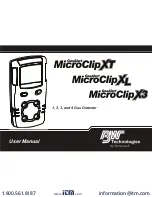
14
12.4
95-8616
MAINTENANCE
NOTE
Refer to the GT3000 Safety Manual (number
95-8685) for specific requirements and
recommendations applicable to the proper
installation, operation, and maintenance of all
certified SIL 2 capable GT3000 gas detectors.
ROUTINE INSPECTION
The gas inlet to the sensor should be inspected
periodically, or during scheduled maintenance, to
ensure that external obstructions such as plastic bags,
litter, heavy oil and tar, paint, mud, snow, or other
materials do not block the flow of gas to the sensor,
thereby impairing the performance of the device.
To replace a dirty or damaged filter, simply grasp the
filter assembly and twist counterclockwise to remove.
Screw the new filter in place on the sensor module. Do
not overtighten. See Figure 14.
To ensure reliable protection, it is important to check and
calibrate the detection system on a regularly scheduled
basis. The frequency of these checks is determined by
the requirements of the particular installation – typically
30, 60, or 90 day intervals, depending on the ambient
conditions.
SENSOR MODULE REPLACEMENT
(Live Maintenance)
The hot swappable, intrinsically safe sensor module
can be replaced in the field without removing power or
de-classifying the hazardous area.
To replace the sensor module, locate the three captive
screws on the front of the module as shown in Figure
15. Loosen these screws and remove the old sensor
module. Install the new sensor module onto the
transmitter, and tighten the screws. To ensure proper
moisture ingress protection and grounding of the
plastic nosepiece, tighten the screws to 70-100 oz-in
(0.5-0.7 N-m).
IMPORTANT
Always exercise caution when working in
combustible gas areas. Follow replacement
instructions explicitly.
NOTE
Removing the sensor module with power applied
will result in a fault condition until a new sensor
module of the same type is installed. When
replacing an oxygen sensor, this action will result
in an alarm condition as the decreasing 4–20 mA
signal passes through the alarm range. Inhibit
response devices to prevent unwanted actuation.
NOTE
Oxygen (O
2
) electrochemical sensors contain
lead (Pb). Observe all local waste management
requirements when disposing of exhausted O
2
electrochemical sensors.
NOTE
Electrochemical sensors are highly sensitive
to antiseptic wipes and/or cleaning products
that contain alcohol and antibacterial/antiviral
agents. Antiseptic products should be removed
from areas where sensors are stored, handled,
or used. If antiseptic products are being used on
workers' hands, sufficient time should be allowed
for the alcohol to evaporate before handling
sensors.
LOOSEN CAPTIVE PHILLIPS
SCREWS (3) TO REMOVE
SENSOR MODULE.
B2451
Figure 15—Location of Screws for Sensor Module Replacement
Figure 14—GT3000 with Replaceable Filter Removed
TURN FILTER COUNTERCLOCKWISE
TO REMOVE. NO TOOLS REQUIRED.
A2481














































